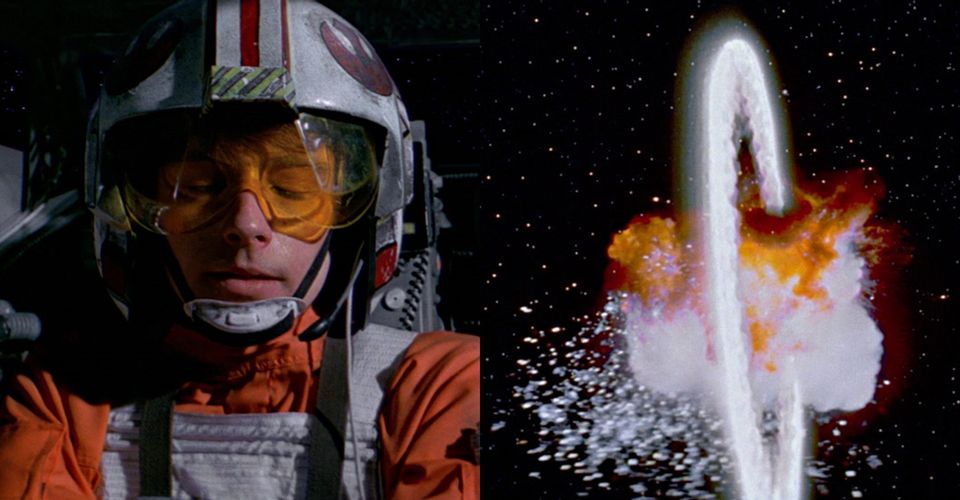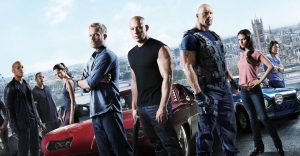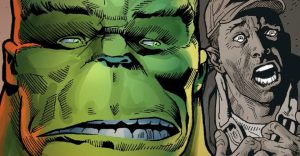Star Wars: 10 Ways The Death Star Trench Run Is The Saga’s Greatest Space Battle

Based on the name of the Star Wars saga, it’s hardly surprising that the movies contain plenty of spectacular space battle sequences. From the battle over Coruscant that opens Revenge of the Sith to the Falcon outrunning the Imperial fleet through an asteroid field in The Empire Strikes Back, there are a bunch of classic space battles throughout the movies.
But the bar that still has yet to be topped is the climactic sequence from the original 1977 movie. The Rebels’ bid to destroy the Death Star is still the benchmark for Star Wars’ space battles for several distinct reasons.
10 It Completes Luke’s Hero’s Journey

Luke Skywalker’s arc in the original Star Wars movie was inspired by the “hero’s journey” outlined by Joseph Campbell in his writings on the “monomyth.”
By the time he blows up the Death Star, Luke has answered the call to adventure, lost his mentor, and faced a bunch of trials and tribulations along the way. The destruction of the Death Star completes Luke’s hero’s journey in spectacular fashion.
9 General Dodonna’s Briefing Perfectly Sets The Stage For The Death Star Assault

Before the Rebels go up in their X-wings to take on the Empire’s superweapon, General Dodonna runs through the battle strategy during a briefing at the Yavin 4 base. After this briefing, the audience is crystal clear on the plan and can just sit back and enjoy the action.
With on-screen diagrams detailing where the thermal exhaust port is and Dodonna explaining the dangers of the trenches, this sequence perfectly sets the stage for the excitement of the Death Star assault.
8 The Stakes Are Clearly Established

The problem with a lot of big battle sequences in modern blockbusters is that the stakes aren’t clearly established, so the audience has no emotional connection to the on-screen carnage. Fortunately, there’s no such problem in Star Wars.
The audience knows how difficult it will be to shoot a proton torpedo into the thermal exhaust port, and that the Empire will have the power to destroy a bunch of dissenting planets if the Rebels’ plan fails.
7 John Williams’ Score Creates Palpable Tension

Throughout the Battle of Yavin sequence, John Williams’ breathtaking score builds up a palpable tension around the action. His bold orchestrations masterfully build up to the explosion.
As the last few sparkles of the Death Star fizzle out in the void of space, Williams relieves the tension and celebrates the Rebels’ victory with a few light and twinkly notes. It’s a perfectly pitched soundtrack to such an iconic movie event.
6 The Mission Is Initially A Failure

After Lucas establishes Chekhov’s plan with General Dodonna’s briefing, that plan goes horribly wrong in the first few minutes of the Battle of Yavin. Rebel pilots are shot down left and right and none of them manage to land a torpedo in the thermal exhaust port.
The best battle sequences have their own story structure, and this is the conflict that raises the stakes in the middle act of that narrative ahead of the triumphant finale.
5 Luke Emerges As The Rebellion’s Underdog

At the beginning of Star Wars, Luke Skywalker is just a bright-eyed farm boy who dreams of one day joining the Rebellion’s fight against the Empire. By the end of it, he has stepped up to the plate and become the hero of the entire Rebellion.
After the Rebels’ best pilots fail to sink a torpedo into the Death Star’s thermal exhaust port, Luke rises up as the Rebellion’s underdog when he uses the Force to do what the greatest fighter pilots in the galaxy couldn’t.
4 Han’s Triumphant Return Is His Greatest Character Development

Han went on a generic hero’s journey in Solo: A Star Wars Story, which negated his character development in the original trilogy. The real moment that Han becomes a hero is when he triumphantly returns in the Falcon and shoots the TIE fighters off Luke’s tail, allowing Luke to blow up the Death Star.
There were other moments throughout the trilogy that brought Han away from his roots as a scoundrel and further into heroic territory, but this change of heart is the most cathartic.
3 Darth Vader Survives The Battle

It would’ve been easy for George Lucas to kill off Darth Vader in the Battle of Yavin, but he had bigger plans for the iconic villain. Leaving Vader alive in the final battle of Star Wars – despite the fact a sequel wasn’t a given – ended up helping the original trilogy in the long run.
Vader’s survival allowed the sequels to build on his arc. He was eventually reframed as a tragic hero as he was revealed to be Luke’s father, a fallen Jedi, and the puppet of an even more ruthless baddie, the Emperor.
2 Ben Kenobi Offers Poignant Wisdom From Beyond The Grave

The Battle of Yavin feels so emotionally satisfying because it pays off all the threads seen throughout the movie. While Luke is trying to get a good shot at the thermal exhaust port, the disembodied Force ghost of his late master Ben Kenobi is heard and tells Luke to use the Force.
This paid off Luke’s father-son dynamic with Ben and his early Jedi training, as well as unifying the spirituality of the Force-related aspects of the story and the political overtones of the Rebels-versus-Empire aspects.
1 The Death Star’s Explosion Is Suitably Glorious

Obviously, the greatest moment in this set piece is when the Death Star actually explodes. After landing a torpedo on target, Luke quickly leaves with Han and the other Rebels, the camera lingers for a second, and the station is blown to a million pieces.
This giant cosmic explosion is suitably glorious and cinematic. The triumph of the Death Star being blown to smithereens will never get old. Star Wars fans celebrate this moment over and over again and likely will do for generations to come.
About The Author

















